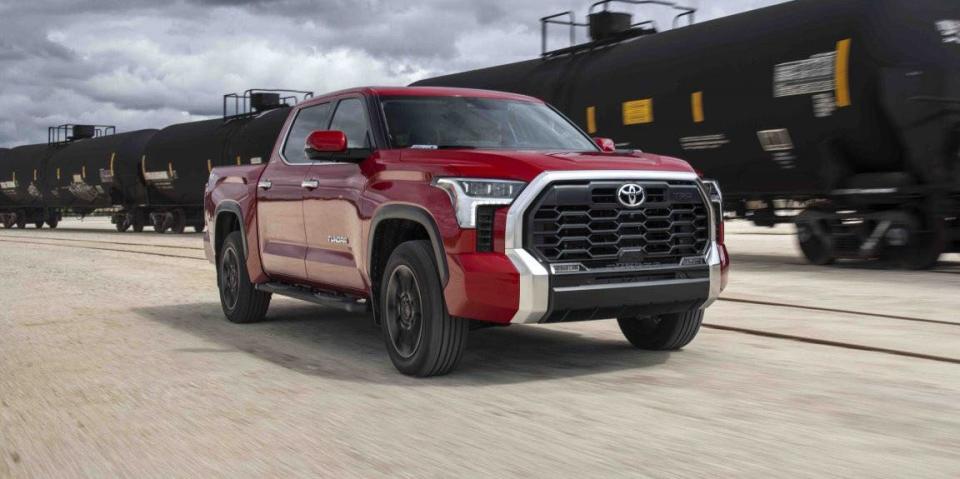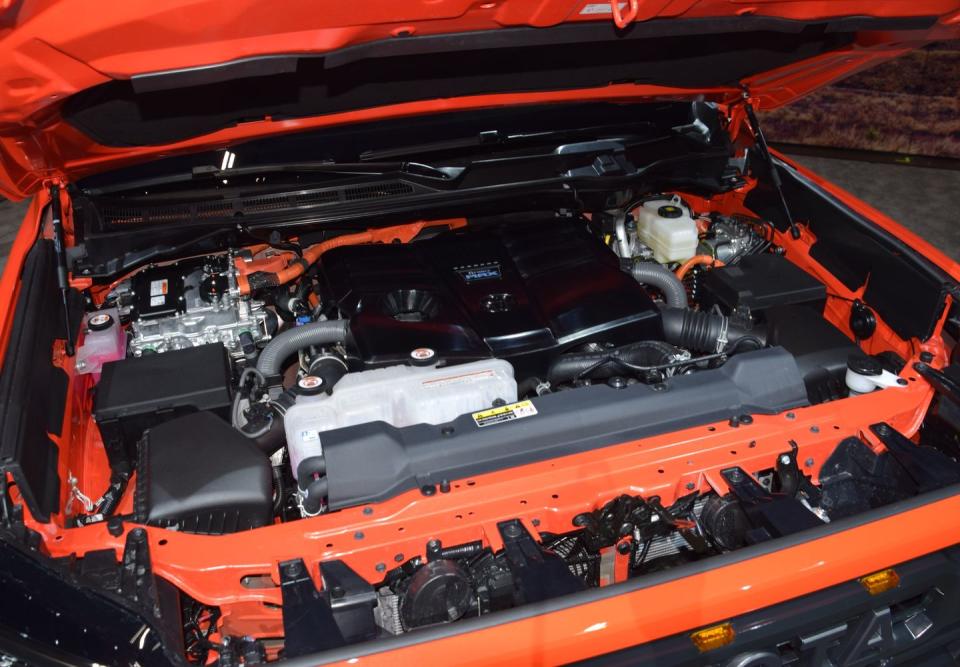Toyota Extends Hybrid Strategy to Fullsize Trucks

Toyota rolled out its newest-generation Tundra full-size pickup truck late last year, dropping the V8 option and offering it solely in turbocharged V6 form.
Joining the Tundra lineup this spring is the i-Force Max trim, Toyota’s designation for the hybrid model, with an output of 437 hp and 583 lb-ft of torque.
It will join the popular Ford F-150 hybrid pickup as the two sole full-size trucks offering hybrid powertrains.
Toyota is excited to have a fully re-engineered Tundra pickup in the market, rolling out to North American showrooms a few months ago. Still ramping up production, the brand delivered 4952 units in January, produced at the automaker’s plant in San Antonio.
For context, Ford sold 50,543 full-size F-Series pickups (including heavy-duties) in the same month, outpacing the Tundra more than 10 to 1. For full-year 2021, Ford sold 656,039 F-Series trucks in the US while Toyota delivered 81,959 Tundras, nearly all of them from the previous generation.
So let’s be realistic. How much indigestion is an all-new Toyota full-size pickup causing sales managers at Ford, General Motors, and Ram, the brands in Detroit that dominate this lucrative segment and which are none too eager to surrender 1 point of market share?
It’s important to note, Ford and GM—America’s top two full-size truck producers—throw a huge variety of powertrains at shoppers: V6s, V8s, diesels, gasoline, naturally aspirated, turbocharged, even a four-cylinder engine from GM.
Toyota, even for its brand-spanking new third-generation Tundra, keeps the initial powertrain offering simple, limited to one engine only: a dual-overhead-cam, twin-turbo 3.5-liter i-Force V6 rated at up to 389 horsepower, mated to a 10-speed automatic with two-wheel or four-wheel drive. Gone are the 4.6-liter and 5.7-liter naturally aspirated V8s previously offered.
That changes this spring when Toyota will begin selling the same engine in a full parallel hybrid configuration, with an electric motor/generator positioned between the engine and transmission. By itself, the electric motor can crank out 48 hp and 184 lb-ft of torque, with excess energy stored for later use in a 1.87 kWh nickel-metal hydride battery pack.
Electrification boosts overall output of this hybrid powertrain (marketed as i-Force Max) to 437 hp and 583 lb-ft of torque—competitive in the segment and a monumental step up from the previous-generation Tundra.

This is potentially a smart strategy for Toyota. Instead of throwing multiple powertrains at shoppers, the automaker focuses exclusively on a stout turbocharged V6, which Ford rode all the way to the bank with its 3.5-liter EcoBoost, launched years ago in the F-150.
The other side of the strategic coin could be just as valuable—turning this Toyota V6 into a hybrid, a concept the Japanese automaker likewise rode to the bank with the 2001 launch of its popular Prius. In spring, when the Tundra Hybrid launches, it and the F-150 will be the only full-hybrid full-size pickups.
Toyota is expecting about 25% of Tundra buyers to pick the hybrid. Ford isn’t disclosing the current take-rate for the F-150 PowerBoost hybrid, but product planners said at the launch more than a year ago they expected about 10% of buyers to pick the hybrid, which carries a starting price of $48,480, in Lariat trim. Pricing for the Tundra Hybrid starts at 52,300.
Michelle Krebs, executive analyst at Cox Automotive, says she expects Toyota will do well with a hybrid Tundra, based on Ford’s success with its own hybrid F-150.
“And Toyota has experienced tremendous success with hybrids,” Krebs says. “Toyota, wisely, has added hybrid and/or plug-in hybrid versions to its most popular models. Hybrids/plug-in hybrids, along with a tiny number of fuel-cell vehicles, now account for about a quarter of Toyota’s sales. That’s a higher percentage of electrified sales than any automaker.”
Toyota’s been here before, offering hybrid versions of its high-volume models—namely the Camry, RAV4, and Highlander. “So there is no separate marketing required,” Krebs says. “Those hybrids have been in extremely high demand and, through the chip shortage, in low supply.”
Dearborn executives must be fuming that the new Tundra Hybrid trumps the F-150 Hybrid’s 430 hp and 570 lb-ft of torque.
Ford has the upper hand in fuel-economy ratings, however, with a combined 24 mpg with four-wheel drive, easily besting the Tundra’s 21 mpg combined in most trim levels. With rear-drive versions, again Ford has the edge, with a combined 25.5 mpg rating for the F-150 Hybrid, compared with a combined 22 mpg for the 2WD Tundra Hybrid.
All-electric full-size pickups (from Ford, GM, and later Ram) are just around the corner. For now, Ford and Toyota duking it out with full hybrids will provide the electrifying drama.
Share your thoughts on the electrification of the Toyota Tundra and whether you think it will give the hybrid Ford a run for its money.

 Yahoo Autos
Yahoo Autos 